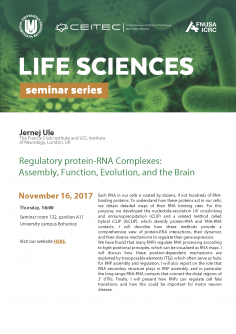Abstract
Each RNA in our cells is coated by dozens, if not hundreds of RNA-binding proteins. To understand how these proteins act in our cells, we obtain detailed maps of their RNA binding sites. For this purpose, we developed the nucleotide-resolution UV crosslinking and immunoprecipitation (iCLIP) and a related method called hybrid iCLIP (hiCLIP), which identify protein-RNA and RNA-RNA contacts. I will describe how these methods provide a comprehensive view of protein-RNA interactions, their dynamics and their diverse mechanisms to regulate their gene expression.
We have found that many RNPs regulate RNA processing according to tight positional principles, which can be visualised as RNA maps. I will discuss how these position-dependent mechanisms are exploited by transposable elements (TEs), which often serve as hubs for RNP assembly and regulation. I will also report on the role that RNA secondary structure plays in RNP assembly, and in particular the long-range RNA-RNA contacts that connect the distal regions of 3’ UTRs. Finally, I will present how RNPs can regulate cell fate transitions, and how this could be important for motor neuron disease.








